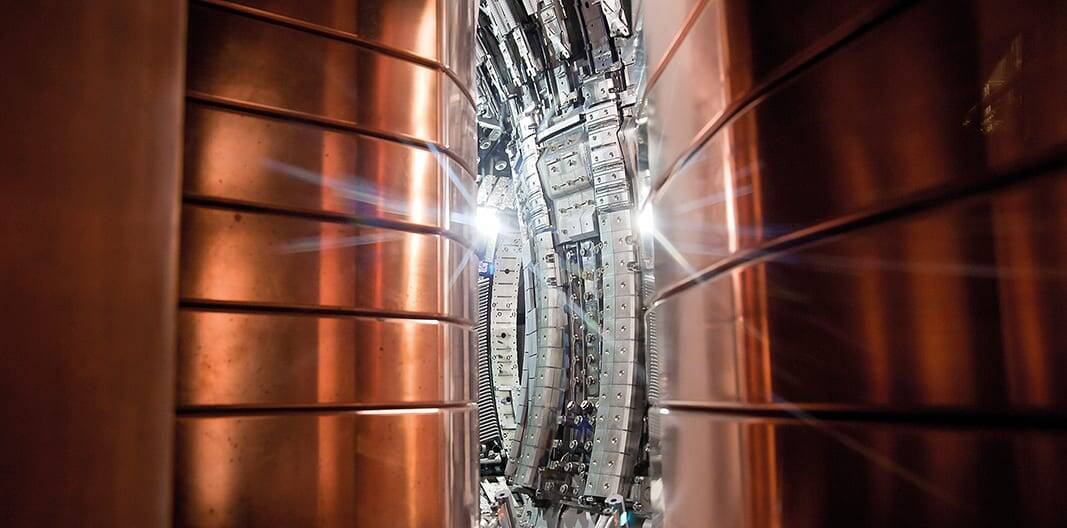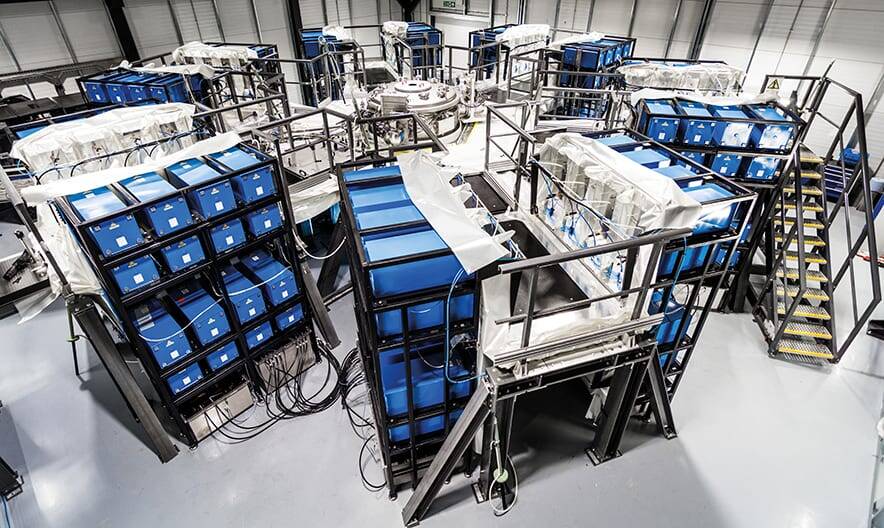This is the Sponsored paywall logged out

Nuclear fusion is seeing a surge of activity and investment. Greg Jones visited the UK’s Culham Science Centre and spoke to a start-up to find out whether energy’s Holy Grail is within grasp.


Since the concept was first envisaged in the 1930s, the dream of generating electricity through nuclear fusion has been one of boundless energy from effectively limitless fuel.
Despite its potential, and plenty of research, we still have not reached the destination. In fact, it has become something of a joke in the industry that fusion is always “30 years away”. So where are we now?
As the technology continues its long development, the fusion start-up scene is seeing increased interest. Co-ordinated government-funded research efforts continue to strive to deliver what is the ultimate green energy prize. Alongside this, private investors have emerged in recent years as companies across the world explore more experimental methods promising faster results than the conservative estimates of government-backed initiatives.
The biggest player in the UK is the Culham Centre for Fusion Energy (CCFE) in Abingdon, Oxfordshire, located on the site of a former Royal Navy Air Station. The CCFE hosts both Britain and Europe’s foremost fusion research programmes and the complex is situated on a wide, flat field, where 75 years ago hangars housed Supermarine Seafires and Hawker Sea Furies.
Today, the buzz of propeller planes has been replaced by more terrestrial engines. Within the buildings, however, operations are far from mundane.
CCFE houses two tokamak (see box, p14) fusion reactors, the Joint European Torus (JET) and the Mega Ampere Spherical Tokamak (MAST). The goal is to clear the way for cheap, clean energy production at a scale we have yet to see on Earth.
Nuclear fusion is the means by which our Sun produces the heat and light that sustains us, reaching 15 million degrees Celsius at its core. Here, hydrogen atoms are fused to form helium. This reaction is exothermic, meaning it has a net positive energy release, which results in the radiation the sun emits.
This energy release is the basis for fusion generation. Theoretically, a controlled fusion reaction would be able to produce energy far more efficiently than fission reaction or the burning of fossil fuels, with the added benefits of a plentiful fuel supply and markedly less environmental and safety concerns.
As it stands, it requires more energy to create the conditions required for fusion than is released by the reaction itself. The most efficiency that has been recorded so far at Culham was achieved by JET, when 25MW of energy was inputted and nearly 17MW generated from the subsequent reaction.
This is where the National Fusion Technology Platform (NFTP) comes in. The NFTP has two main objectives: identifying suitable reactor materials that can stand up to the heat and radiation; and identifying a process to produce one of the fuels for fusion, tritium, in the reaction itself.
Announced at the start of the year, the platform is set to open in 2020, having secured £86 million in funding from UKAEA (the UK Atomic Energy Authority).
Like most government-funded fusion research, the work of the NFTP will stream into the greater current of the International Thermonuclear Experimental Reactor (ITER). ITER is a multinational mega-project, with 35 nations who have come together to build the world’s largest fusion reactor, in France. It is set to cost more than €20 billion and has a completion date of 2025.
The NFTP is particularly concerned with preparing UK industry to win contracts with ITER. Colin Walters, the director of NFTP, says he wants to “make sure we’re doing everything we can with UKAEA to enable UK industry to play as big a part as possible”. UK businesses have already been awarded contracts to the tune of £500 million, with the current target being a further billion.
The road to commercial fusion is still a hard one. Currently, much of the research in the UK is carried out with ITER in mind. According to the official timeline, ITER should be completed by 2025 and run until 2050. In this time, the construction of DEMO will begin, which will serve as the first reactor designed with the intention of generating power for the grid.
It appears therefore that commercialised fusion power is, at least according to the public timeline, indeed still 30 years away. The UK needs a renewable overhaul sooner rather than later, and if fusion is still decades away it will be unable to play the role many had hoped for.
The question, then, is does fusion need more funding to push it through. Walters says it does, although he freely concedes: “I would say that, wouldn’t I.”
In truth, “like any big scientific or engineering programme, to an extent the speed would be dependent on the amount of investment”. As an example of what can be accomplished with cash if you set your mind to it, he cites the rapid development of aeroplane technology during the Second World War.
When it comes to climate change, fusion is not the silver bullet some had hoped. Walters says climate change is “a really serious issue that we’ve got to address in the medium term, and in some cases in the shorter term.
“Fusion is beginning to attract investors who see it as a long-term investment, but it is long term, it’ll be a couple of decades at least before we get any sort of power to the grid.”
Fusion has huge potential, and Walters says that “with the green credentials and an abundance of the potential fuels, it ticks an awful lot of environmental boxes”. While nuclear fission – deployed in all commercial nuclear reactions built so far – is proven, it is also controversial in terms of its environmental footprint.
While it would be wrong to say that there’s no radioactive waste, the volumes produced by fusion reactors are “considerably smaller, and the half-lives of the materials are considerably shorter”. Instead of actinides like plutonium, uranium, or neptunium, which can have half-lives ranging from hundreds to thousands of years.
For fusion, the waste concern is tritiated materials, because “tritium’s very mobile, and will enter into the matrix of materials”, and neutron activation where the materials become radioactive. Radioactive materials such as fusion reactors are only expected to be at dangerous levels for 50 years, and after 500 years will be as radioactive as coal ash.
Brexit and beyond
International co-operation plays a huge role in public fusion research. Culham currently has 350 overseas researchers stationed there. “You’ve only got to look at the names on the doors as you walk around this building, and that’s brilliant,” says Walters.
JET is a testament to the willingness to pool resources and knowledge, now and in the future. The programme recently received funding from the EU for a further two years, to the tune of at least €100 million .
Walters says this is endemic of “the level of interaction” and, he believes, the agreement for the extension of JET is the only current agreement between the UK and the EU that will be unaffected “whatever form of Brexit or no Brexit”, regardless of “the deal, no deal, good deal, bad deal”.
Former prime minister Theresa May assured the centre that continued co-operation after the UK’s withdrawal from the EU was in the interest of both parties, and her successor, Boris Johnson, has already made a visit to CCFE in his short tenure, where he reiterated the government’s support for the research.
Walters is unwilling to say whether ITER’s road map could be improved upon, because “history is littered with people over-promising”.
However, he does say: “To a degree, it depends on how much effort you put in. If human kind took the challenge a little bit like the Apollo programme, then you could fast track things, but in the normal state of affairs, it’s going to be several decades yet.”
He says that in 1959 the US struggled to get a rocket off the ground, but ten years later they had a man on the moon, which was the result of having brainpower and support coming together towards a
single goal.
He says “the brains are not just here, but around the world, and if we all work together, and I know it sounds a bit utopian, but we could make a difference”.
When fusion does become a reality, Walters is keen that we “don’t repeat what the West did with oil”. He stresses the need to avoid over-reliance on one fuel source, because it leaves us open to exacerbated suffering from political and economic changes.
“We’ve got to do a sort of hindsight study as a human race and think to ourselves we’ve got to be cleverer next time. It needs everybody to think together.
“ITER has demonstrated that we can actually all work together… it can be done if everyone puts their mind to it, if the prize is big enough, and it’s shared.”
Making the science stack up
At the Culham Centre for Fusion Energy, the fusion reactors use fuel composed of an equal mixture of deuterium and tritium, two isotopes of hydrogen. This is because the fusion reaction between these two requires the least energy and is easiest to initiate.
Deuterium and tritium have one and two neutrons respectively in their nuclei, in contrast to the zero found in hydrogen. Under the right conditions, they join to form helium, a single neutron, and with it the release of energy.
The issue is that, despite this being the easiest reaction to make happen, attempts up till now consume more energy than is released. The process needs to become much more efficient before viable generation is a reality.
One of the main problems with fusion reactors thus far is maintaining plasma stability for extended periods. Plasma is a superheated gas that becomes a cloud of ions and free electrons, and is the environment necessary for fusion to occur. Crucially the plasma can only be held stably in a vacuum, suspended by a powerful magnetic field, as it cannot come into contact with the materials of the reactor.
JET’s magnets are made with copper coils, which start to overheat due to the huge amount of electricity required to operate them. Presently, you get “about a minute”, and after that “you literally can’t run the machine longer than that, otherwise there’s no machine”, says Colin Walters, the director of National Fusion Technology Platform.
At the moment, Jet can only produce plasma pulses lasting seconds. Looking toward ITER, one if its main purposes is to achieve longer pulses that run for minutes at a time, “to a point where you can get reliable quantities of heat, and we’re talking about 500MW of heat out” for 50MW put in, explains Walters.
ITER, and some start-ups, are planning to overcome this issue by using superconducting electromagnets. Here the containment system will be made with coils of specialist material that has, when cooled to cryogenic temperatures, zero electrical resistance and can operate at length without overheating.
This is not without issue, as these materials must be cooled to near absolute zero in close vicinity of the reacting plasma, which can be in the area of 100 million degrees Celsius.
Once stabilised for longer, the reaction can be made even more efficient by generating tritium in the reactor itself. Of the two fuels for fusion, deuterium can be harvested from seawater, whereas tritium occurring naturally on Earth is rare, so it must be manufactured.
The NFTP hopes to achieve this by finding the most effective ways to place lithium-6 in the reactor and bombard it with neutrons produced by the fusion reaction. This would produce tritium and, ideally, create “a sort of self-sustaining process”.
The greatest material difficulty comes from plasma-facing components, with which there are two main challenges. One is the heat flux, where the internal reactor walls can experience conditions similar to a space craft on atmospheric re-entry, “the other one is the neutron flux, which is very high energy neutrons”. While these neutrons are very useful when they react to produce more fuel, they are less so when they react with structural metals.
Components exposed to neutrons can experience “dislocation”. Walters describes this as neutrons colliding with the atoms of a piece of steel at great speed and knocking them out of the cubic lattice. Like a jigsaw where you have shuffled the pieces around a hundred times; “you might not end up with the original picture”.
Dislocation causes change in the material’s structure at an atomic level, which affects the structural integrity of components and can cause them to become brittle or lose strength, properties that are somewhat undesirable in a nuclear reactor and can mean that a reactor made of unsuitable materials may need constant component replacement to operate.
Finding materials that can stand up to these conditions is especially difficult because “very few organisations have got the challenges we’ve got”. The nature of the problem means CCFE must, in some cases, develop its own materials, which it does with universities, industry, and other research centres.
This is another of the tasks for the NFTP, as the organisation designs tests for simulating the “extremely challenging” fusion conditions, in terms of “heat, vacuums, strong magnetic fields, massive neutron doses”, and identifying construction materials that are up to task.
Target practice: First Light charts a different path to fusion
 In recent years there has been a surge in private enterprises looking to realise the promise of fusion power. The Fusion Industry Association, founded in 2018, is symbolic of the legitimisation of the fledgling industry. Of the FIA’s 19 members, 12 have been formed since 2009.
In recent years there has been a surge in private enterprises looking to realise the promise of fusion power. The Fusion Industry Association, founded in 2018, is symbolic of the legitimisation of the fledgling industry. Of the FIA’s 19 members, 12 have been formed since 2009.
While government projects have tended to operate over very long time scales, a number of investors are seeing fusion research as a viable private investment option that could deliver over the shorter term.

First Light Fusion is one such start-up, based in Kidlington, Oxfordshire. It has been pioneering an alternative fusion method known as inertial confinement, rather than the magnetic confinement used by the industry-standard tokamaks design (see box, Tokamaks, p14).
Gianluca Pisanello, the company’s chief operating officer, thinks small start-ups are an attractive proposition because they can have some advantages over big, national efforts. “The biggest one is definitely agility and the possibility to do things much quicker,” he says. He also believes they can come to decisions faster and use their budgets, while smaller, more efficiently.
Furthermore, Pisanello believes First Light’s approach to fusion suits the size of the company. He explains that the company does have “a big machine”, but the idea is to constantly update it rather than starting from scratch and making each iteration a new big machine.
First Light’s approach hinges on a phenomenon called cavity collapse, which was the focus of founder and chief executive Nicholas Hawker’s PhD thesis. When vapour-filled bubbles of relatively low pressure are created within a liquid, they violently collapse under the higher pressure of the surrounding medium. During this collapse, the bubble is forced down into a fraction of its original size, which creates extremely high temperatures and pressure within; theoretically enough heat and pressure to initiate fusion.
The set-up First Light employs to create these conditions involves a projectile and a target. The projectile, a metal coin, is electromagnetically blasted at 20km/s towards the target, a plastic pod, that contains a suspended bubble of tritium and deuterium. The projectile collides with the target, which causes a shockwave. This compresses the gas bubble inside to a minute volume, causing the high pressure and temperature needed to fuse the isotopes together.
First Light’s approach has several advantages over traditional paths to fusion, such as reduced effects from the neutron flux, because the complex technology of the launching mechanism is distanced from the reaction. Similarly, this leaves plenty of room to encapsulate the reaction with lithium, maximising returns on tritium production. A further efficiency bonus is the fact that inertial confinement does not require any costly magnets to stabilise plasma.
First Light likens the difference between its approach and the approach of other organisations as the difference between a furnace and a combustion engine. The furnace burns steadily and slowly through its stream of fuel, while the engine quickly combusts all of its fuel, which is then replaced and the process is repeated.
In operation since 2011, First Light has so far received £25 million in funding, £23 million of which came in 2014 as funds raised to reach its goal of completing the reaction. First Light finished construction on Machine 3 in February, the device they expect to achieve fusion by the end of the year.
While there is no set date in 2019 when First Light will prove that it can accomplish fusion via its methods, Pisanello is confident. He says it’s “like everything in science, you can’t really stick a date on it”, but “we have very good reasons to expect that we will be able to stick to what we promised”. He adds that, as far as he is aware, First Light is the only fusion start-up “that has always stuck to the timelines”.
Once it has demonstrated fusion, First Light aims to demonstrate energy gain by 2024, a whole year before ITER even has plasma. Pisanello expects that an inertial confinement power station will have a reactor that fires once every five seconds. To reach this stage, First Light will have to initiate another funding round.
There is no figure on how much money will be needed to build a machine that demonstrates energy gain, only that it will be “substantially more” than the previous sums. Part of this five-year project will be dedicated to producing detailed designs on a power plant based on the company’s technology.
First Light’s future business plan – once they have produced fusion reactors – includes manufacturing and supplying the targets. The precise materials and designs of the targets are a commercial secret, one that is vital to the operation of the reactor as a whole.
Pisanello explains that “the target is really where our technology lies” because the design multiplies the velocity of the shockwave. If this was not the case, the projectile would have to be fired at “unrealistic velocities” to achieve fusion.
Currently, First Light has an experimental target design, which he says multiplies the impact velocity by 10.2, compared with the multiplication of 1.5 given by a simple cube shape. With the sale of the targets so integral to the business, Pisanello has no fears that they could be emulated by other companies.
He explains that the target is complex not only in design but in the manufacturing processes involved, so if you were trying to reverse engineer one, you would still need all the necessary infrastructure, and “you don’t know why it works, you don’t know how it works”.
Tokamak nuclear fusion reactors
A tokamak reactor uses a powerful magnetic field to confine a hot plasma in the shape of a torus. It is one of several types of magnetic confinement device that have been developed to produce a controlled fusion reaction but is the leading candidate for a practical fusion reactor.
Tokamaks were initially dreamt up in the 1950s by Soviet scientists. The first working tokamak was the T-1, which demonstrated that a stable plasma equilibrium requires magnetic field lines that wind around the torus in a helix.
The T-1 began operation in 1958 and was widely adopted worldwide. No-one has yet been able to resolve the fundamental problem that the device consumes more energy than it generates.
After an initial agreement between Russia and US in 1985, the International Thermonuclear Experimental Reactor (ITER) effort emerged and remains the primary international effort to develop practical fusion power.
Please login or Register to leave a comment.